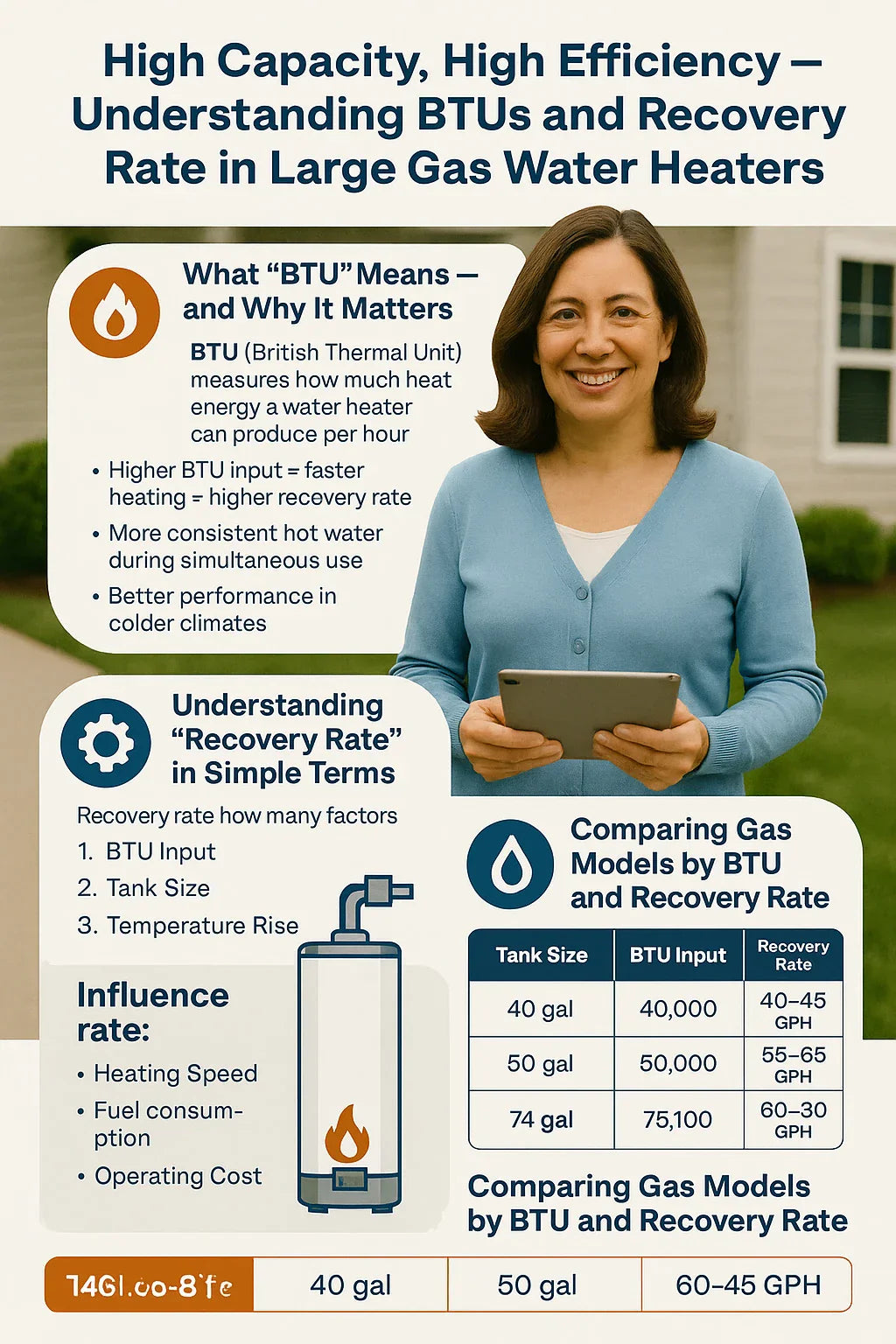When you’re exploring powerful water heaters like the State ProLine High Capacity Atmospheric Vent Series 74-Gallon, 75,100 BTU Gas Water Heater, you’ll often see terms like BTU input and recovery rate. These two specs tell you how well a heater performs under pressure — and how quickly it can restore hot water after heavy use.
This guide breaks down how BTUs and recovery rate work together to determine real-world performance and efficiency, so you can pick the right large-capacity unit for your home or small business.
💡 1. What “BTU” Means — and Why It Matters
BTU (British Thermal Unit) measures how much heat energy your water heater can produce per hour.
-
1 BTU = the energy needed to raise 1 lb of water by 1°F.
-
Higher BTU input = faster heating = higher recovery rate.
For example, a 75,100 BTU gas unit delivers serious heating muscle compared to a typical 40,000 BTU residential heater. That means:
-
Quicker recovery after multiple showers.
-
More consistent hot water during simultaneous use.
-
Better performance in colder climates with low incoming water temperatures.
➡️ Helpful Resource: Energy.gov – Water Heating Basics
⚙️ 2. Understanding “Recovery Rate” in Simple Terms
Recovery rate measures how many gallons of water your heater can raise to the set temperature (per hour).
It’s influenced by three main factors:
-
BTU Input: Higher input = more heat produced.
-
Tank Size: Larger tanks take longer to reheat fully.
-
Temperature Rise: The difference between incoming and desired water temp.
A large gas unit with 75,000 BTU can recover around 80–90 gallons per hour at a 90°F rise, versus only 40–50 for smaller residential models. (Home Water Heater Guide)
🧮 3. BTUs vs. Recovery Rate — The Efficiency Balance
| Feature | High BTU Input | High Recovery Rate | Efficiency Impact |
|---|---|---|---|
| Heating Speed | Rapid heating | Quicker refill after use | 👍 Improved comfort |
| Fuel Consumption | Higher energy draw | Shorter run time | ⚖️ Depends on insulation and usage |
| Operating Cost | Slightly higher if used inefficiently | Lower if matches demand | 💰 Optimized savings when properly sized |
| Ideal Use Case | Multi-family homes or business suites | High-demand environments | ✅ Best fit for >60 gallon systems |
➡️ Reference: EnergyStar Efficiency Standards for Gas Water Heaters
🏠 4. Why BTU Input Matters More in Large Tanks
With big tanks (60-80 gallons +), a strong burner is essential to maintain steady supply.
If BTU input is too low, you’ll have plenty of storage but slow recovery — like a race car with a tiny engine.
-
A 75,100 BTU heater can comfortably serve 4–6 people with multiple bathrooms.
-
A 40,000 BTU unit might struggle if you run laundry and showers simultaneously.
➡️ Further Reading: State Water Heaters – High Recovery Models
⚖️ 5. Balancing High BTU with Energy Efficiency
A common concern: “Won’t higher BTUs cost more to operate?”
Not necessarily — efficiency comes from how the unit uses energy, not just how much it consumes.
Tips to maximize efficiency in high-capacity units:
-
Choose a model with high Uniform Energy Factor (UEF) ≥ 0.60 for gas.
-
Add an insulating blanket if your tank is in a cold basement.
-
Maintain annual flushing and vent cleaning for optimal heat transfer.
-
Set your thermostat to 120°F–125°F to reduce standby loss.
➡️ Efficiency Tips: U.S. DOE – Improve Water Heater Performance
🧰 6. Samantha’s Homeowner Example
“When I installed a 74-gallon ProLine gas heater, the 75,100 BTU rating meant I could run back-to-back showers and still have enough hot water for laundry. The recovery rate made all the difference.” – * Samantha Reyes*
That’s the real-world advantage of pairing large storage volume with high BTU input and fast recovery.
🔍 7. Comparing Gas Models by BTU and Recovery Rate
| Tank Size | BTU Input | Recovery Rate @ 90°F Rise | Typical Use Case |
|---|---|---|---|
| 40 gal | 40,000 BTU | 40–45 GPH | Small home (2–3 people) |
| 50 gal | 50,000 BTU | 55–65 GPH | Medium home (3–4 people) |
| 74 gal | 75,100 BTU | 80–90 GPH | Large home (5–8 people) |
🧠 8. How to Use This Info Before You Buy
Ask these questions:
-
What’s your peak hour demand (gallons per hour)?
-
How many people and bathrooms are using hot water at once?
-
What’s the incoming water temperature in winter?
-
Is your venting system rated for a 75,000 BTU input?
-
Does your utility line support that BTU draw?
If the answers point to high usage and simultaneous draws, a large BTU unit with fast recovery is the best investment for comfort and longevity.
🏁 9. Final Takeaway
High-capacity water heaters like the 74-gallon ProLine Gas Series aren’t just about size — they’re about power and efficiency in balance.
BTUs tell you how fast it heats; recovery rate tells you how well it keeps up with demand.
Together, they determine whether your home gets steady, endless hot water or frequent cold surprises.
If you want to know exactly what BTU and recovery rate your home needs, I can help build a custom calculation based on your household size, bath count, and climate zone — just say the word!







